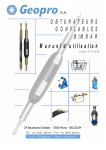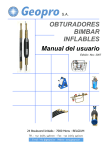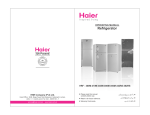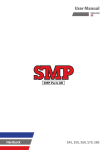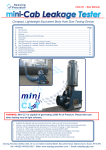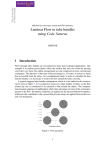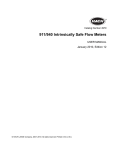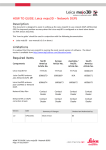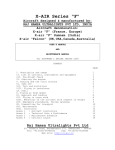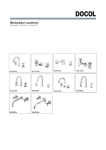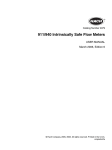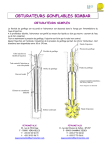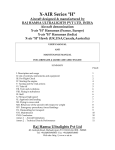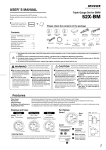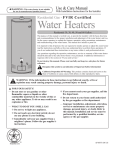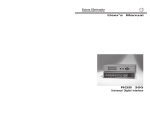Download User manual
Transcript
BIMBAR INFLATABLE PACKERS Instructions for use Issue March 2008 Test Each inflatable element is tested with water in a test bench. After assembly, the tightness of each complete packer is also tested. A test certificate is supplied with each order. Safety and guarantee Our packers are guaranteed free from any defect in material and workmanship. Our guarantee is limited to the repair or replacement of any defective product or parts thereof. This guarantee is void if the products are used in other circumstances than those described in our technical sheets. The decision of our technical department is final. Please contact us for additional information. Considering the nature of equipement working under pressure, users should be aware of the dangers and take the necessary precautions relating to the safety of their employees. Our responsibility ends with our guarantee of good manufacture for the material designed and made according to engineering rules and techniques available at the time of manfacture. Bimbar inflatable packers - Instructions for use Geopro Bimbar inflatable packers are frequently used for grout injection and other geotechnical applications for structural reinforcement and/or water sealing of deep foundations, tunnels, dams and mines. The two main methods for grouting are up-stage grouting, where the grout is injected into the ground below a single inflated packer and tube à manchettes grouting for which our double packers type “ ZI ” are usually requested to inject grout into a PVC pipe . Whether using single or double packers, both grouting methods rely on the use of inflatable packers for efficient and reliable sealing and reinforcement of the geological formations. We will consider the general criteria of importance in selecting and using inflatable packers. The target of this article is to provide advises to the operators to solve the most common problems met with inflatable packers . The ‘’Bimbar Inflatable Packers’’ catalogue is available on our website www.geopro.be Summary 1 – Differential pressure and size 2 – Inflation fluid a – Generalities b – Inflation with gas c – Inflation with water 3 – Inflation control 4 – Inflating the packers 5 – Deploying The packers 6 – Packer failure and service life 7 – Conclusions At rest Single Packer Inflated Single Packer Bimbar inflatable packers – Instructions for use Double Packer Page 1 1 – Differential pressure and sizes The range of Bimbar packers is available in 9 different diameters from 28mm up to 170mm OD. Maximum working pressure (bar) In relation with borehole diameter (mm) These packers are reinforced with two spiraled layers of steel embedded into natural rubber. One layer is spiraled clockwise and the other one is anticlockwise. The two steel layers provide the resistance to the internal and external pressure. The maximum differential pressure decreases with the expansion of the packer as per table1. Do not use the packer at its maximum expansion and keep a reasonnable clearance between the packer and the borehole unless very high working pressure is requested. 2 – Inflation fluid a – Generalities A major consideration is the choice of inflation fluid. Most inflatable packer manufacturers recommend inflation with water for grouting applications whenever possible. Generally the only time it’s not possible is in a dry hole or where the water level is too low. In these circumstances the column of water in the inflation line is too great to allow complete deflation of the packer. Even then, use of special deflation valves (usually requiring two inflation lines) makes use of water inflation possible. We will describe later the functionning of these deflation valves. Water inflation is usually preferred because water inflated packer , after establishing an initial seal , will remain inflated up to the burst pressure of the packer owing to the incompressibility of the water. In contrast , a gas inflated packer can only provide a seal if the gas pressure is maintained at a level above the sum of the sealing and grouting pressures. Leaks, relaxation, soil movement, excess grouting pressure, etc… can all lead to bypass of the inflated packer without the operator’s knowledge. After some time and hardening of the cement , the packer will become difficult or impossible to retrieve. Moreover, quick pressure pulsation of the grout pump can also generate a packer movement in the borehole if it’s inflated at a too low pressure causing a fast destruction of the outer cover of the Bimbar rubber as the packer is not anchored properly. See figure 1 Table 1 Packer inflated with gas at too low pressure Cement Outer cover damage Cement By pass In fact, any liquid provide the same inflation benefits as water and in sub-zero temperatures other water/antifreeze solutions (glycol) must be used. Where possible however, water is the preferred liquid since it’s nonpolluting, readily available and will not damage the rubber. (Note : Bimbar packers are made of natural rubber and are not compatible with oil inflation). The major drawback with using water for inflation is that deflation is slower than when using gas and it may be more inconvenient to operate a manual inflation pump in some circumstances. When gas inflation is chosen, operators will use compressed air , nitrogen or any neutral gas. Bimbar inflatable packers - Instructions for use Rubber deformation Figure 1 Page 2 Example see figure 2 Under no circumstances should oxygen be used as it may cause explosive failure of the packer ! The operator should always check and monitor carefully the inflation pressure when gas is used to inflate the packer. Max. grout pressure = 70/10 x 1.3 + 20-50/10 = 24.1 bar Min. gas inflation pressure = 3 + 24.1 x 0.15 + 24.1 = 30.7 bar Recommended gas inflation pressure = 30.7 x 1.3 = 40 bar Max. working pressure (table 1) : 80 bar ? OK On the other hand, the deflation ability of the water inflated packer must be carefully checked before use . b – Inflation with gas Gas inflation pressure is of critical importance and must be carefully calculated and monitored during grouting operations to avoid premature damage and destruction of the packer. For any particular application, the minimum inflation pressure required (in unit of bar), as read on the surface pressure gauge , can be calculated as follows: Min. Gas inflation pressure = pressure to inflate to hole diameter + sealing pressure + max. grout pressure Note that the “maximum grouting pressure” is the grouting pressure below the packer, not the surface pressure at the gauge of the pump . It is calculated as follows: Packer : Ø56mm Hole diameter : 3” (76mm) Setting depth : 70m WSL: 20m Grout S.G : 1.3 Surface grout pressure: 20bar Max. grout pressure = (depth of the packer (m)/10 x S.G of grout) + surface grouting pressure – (column of water above the packer (m)/10) The pressure required to inflate the packer up to the hole diameter is given by the inflation curves but can be estimated in the field before starting grouting operations. To estimate the sealing pressure (really a safety factor to assure adequate sealing) , a value of 15% of the maximum grouting pressure should be used as a rule of the thumb. The RECOMMENDED gas inflation pressure = minimum gas inflation pressure x 1.3 (safety factor) This safety factor is used to guarantee the anchoring of the packer in the borehole. This value should be compared with the table giving the maximum working pressure in relation with borehole diameter and should be always inferior to the value found in the table 1. Bimbar inflatable packers - Instructions for use figure 2 Safety Another prime consideration with gas inflation is the safety aspect of dealing with high pressure gas. A gas inflated packer is basically a bomb and should be treated as such. If rupture it has potential to do lethal damage. Under no circumstance should gas be used to test inflate packer in open air. Test inflation should always be conducted using water for inflation in a pipe and with adaquate protection to personnel against injury by projectiles ejected from the pipe should the packer fail. Page 3 c – Inflation with water Water is not compressible and therefore it doesn’t provide the explosive effects of gas. A water inflated packer will react as a hydraulic seal. Inner (inflation) and outer (grouting ) pressures will equilibrate automatically and the control of the inflation pressure is much less critical. The RECOMMENDED water inflation pressure = Pressure to inflate to hole diameter + sealing pressure + maximum grout pressure – packer setting depth (m)/10 Once again, this water inflation pressure should be inferior to the value given by table 1 On the other hand, the water column located inside the inflation line will create a hydrostatic pressure and make the packer sometimes difficult or impossible to retrieve (in vertical holes, consider ten meter of depth = 1 bar inflation pressure). The hereunder table 2 shows the maximum setting depth of water inflated packer in function of borehole diameter assuming that the borehole is dry. Table 2 Bimbar inflatable packers - Instructions for use If static water level (SWL) is located above the packer, the column of water above the packer in the borehole will help to deflate the packer. Max. setting depth (m) = table 2 value + Packer depth below water (m) Deflation valve principle If the setting depth of the packer is below the max. setting depth and still to benefite the advantages of water inflation, a deflation valve can be used. The deflation valve is connected onto the fixed end of the packer using the second inflation port . It requires to run a second line. To deflate the packer, an air pressure is set through the second line and the water will escape through the holes located at the bottom of the deflation valve. see figure 3 Figure 3 Page 4 3 – Inflation control Regardless of the type of packer or the inflation method, it is critically important to have an inflation system that provides sufficient control and monitoring functions. The assembly shown in figure 4 (or equivalent set-up) is considered to be the minimum for safe, efficient operations. The system basically requires: a pressure source, an isolating valve, a vent valve, a pressure gauge, suitable hose to connect to the packer and between the other items. suitable inflation fluid , inflation control and monitoring system , it’s time to connect it all up and trial inflate the packer. If gas inflating, trial inflations should only be performed in a pipe of adequate thickness and with appropriate safety precautions. If inflating with a fluid, trial inflations may be performed free in air but are probably more usefully done in a pipe . Trial inflation allows the operator to check for system performance and leaks. Specifically, the operator should be checking inflation pressure to firm contact with the test pipe wall and packer integrity at the maximum pressure. It is best to perform trial inflations with the full length of inflation tube that will be run in the hole to reach the maximum setting depth of the packer. This allows the operateor to time inflation and deflation, get a indication of pumping pressures during different stages of inflation and, for a liquid inflated packer, primes both the packer and the inflation tube. figure 4 Remarks ? The pressure gauge cannot be accidentally isoled from the packer and so always indicates the packer pressure. ? The pressure source is independently isolated from the packer. This is of great importance with gas regulator since they can easely be set at very high pressures or not be properly shut down. In fact, the temptation is to leave the regulated gas connected to the packer at pressure which may lead to packer over-expansion and sub-sequent failure. ? The vent valve ensures that the packer can be safely deflated. ? Being small, self contained and portable (if provided with suitable hose lengths), the gauge set can be moved to the most convenient location to control and monitor the packer during inflation and grouting operations. Clearly, all components used in the inflation control system must be adequate pressure rating. In the case of gas inflation, if operating deep in a water filled hole the surface gas pressure may easely be over 70 bar and adequate precautions are required. The pressure gauge should be chosen such that the maximum inflation pressure lies in the middle third of the gauge’s scale. Pressure gauges are delicate instruments that require careful treatment and regular calibration to ensure their reliable operation. The general characteristics of packers whether inflated with liquid or gas is that the bulk of the inflation volume is placed into the packer at relatively low pressure and it is only the last little bit of volume that is placed at increasingly higher pressure. Charting inflation pressure against time leads a curve showing low, steady pressure increase over an extended period followed by a rapid pressure increase (after wall contact is achieved) in a relatively very short time. This characteristic takes some time to getting used to and operators should be encouraged to use the trial inflations to accustom themselves to the pressure, volumes and times involved. 5 – Deploying the packer The usual deployment methods are via a rigid pipe or a hose. The later is quicker but provides limited depth control, no packer hold-down capacity and limited support for inflation tubes. It’s also depth limited by the self-supporting capacity of the hose and it’s connection to the packer for which reason a safety wire is sometimes used along with the hose. Depth limitations may also be due to the handling capacity of the hose raising and lowering system which is frequently manual. Using a rigid pipe for running the packers offers good depth control, good support for inflation tubes and some hold-down capacity. However it generally requires a mechanized system (drill rig or crane) to handle the rods due to their length and weigth and thus is much slower and more cumbersome. 4 – Inflating the packer Once the packer size has been chosen along with a Bimbar inflatable packers - Instructions for use Page 5 6 – Packer damage and service life Packer damage during grouting operations is generally due to one of the following reasons: 1 – Over-expansion – caused by inflating in too large borehole or a washed out section of the hole or, occasionally, in a yielding soil such as weak clay. If the operator expects such geology, water is recommended to inflate the packer so that volume of water requested to inflate the packer can be monitored and controlled. 2 – Outer cover of rubber cutting – caused by any sharp object in the borehole, eg. end of casing or a casing joint or sharply fractured rock. This problem becomes more critical in inclined or horizontal holes as rubber of the packer is in contact with the rock formation when run in or out. Protection rings can be used under these circumstances on both sides of the packer. see figure 5 figure 5 6 – Deterioration of the rubber in packers due to direct sunligth or high temperature conditions or solvents exposure. Packers should always be stored in boxes to protect the rubber against U.V. 7 – Inflating natural rubber packers with oil will cause excessive swelling and associated softening of the rubber. 8 – Long term inflation with gas (though rarely a criteria in grouting operations) often cause rubber blistering and delamination after the packer is removed from the borehole .The gas which has been absorbed into the rubber under pressure will be collected in pockets forming sometimes ‘’bubbles’’ on the outer cover of the packer. 9 – Cement by pass of packer when used for long grouting periods (several hours) in cracked or fractured rock formations. Longer packers should be used in this case. see figure 6 figure 6 7 – CONCLUSIONS 3 – Over-pressurization – Packers are rated for specific pressures in specific diameter holes and overpressurization is caused by using packer’s too high pressure rating . Always refer to manufacturer’s diameter in relation with pressure rating charst before deciding on an inflation pressure. 4 – Moving a packer when it’s still partially inflated can damage it either by excessive wear against the hole wall or by pulling the steel ends off the rubber, either partially or completely. 5 – Grout contamination of a sliding end packer mandrel can prevent the packer end from sliding and/or damage the sliding end seals. Bimbar inflatable packers - Instructions for use Assuming that the packers are well maintained and adequately stored between uses, and if they are used in accordance with guidelines given in this manual, then inflatable packers should provide long term reliable service for grouting operations. There is no intrinsic reason why tens or even hundreds of grouting operations may not be performed with a single packer. When such service life is not realized it is frequently due to one or more of the factors highlighted above. It is hoped that this article will serve to remedy these problems and that, with such knowledge available, contractors will ensure that their operators are appropriately trained. Page 6 Single, double packers and dilatable element - Order references Dilatable element S Ø28 up to 170mm Single packers SP Ø28 up to 42mm Single packers SP Ø56 up to 170mm Double packers DP Type ZI Ø28 up to 42mm Double packers DP Type ZI Ø56 up to 102mm Double packers DP Type WTP Ø56 up to 170mm How to order ? Diameter (mm) S, SP or DP Dilatable element length (mm) Type ZI or WTP Injection zone Or Test zone Length (mm) Example : Double packer Ø42, Element length 300mm, ZI Type, Injection zone 500mm 4 2 D P 3 0 0 Z I 5 0 0 42.DP.300.ZI.500 Geopro is constantly improving its products and therefore reserves the rigth to change design, materials, specifications without notice. Bimbar inflatable packers - Instructions for use Page 7 Inflation adapters for packers Converting of inches to millimetres Bimbar inflatable packers - Instructions for use Page 8 Different types of packers WTP Bimbar inflatable packers - Instructions for use TZ ZI Page 9 Bimbar inflatable packers - Instructions for use












